
Digital Interfacing
Action and Perception through Technology
Seiten
2020
Routledge (Verlag)
978-0-367-58367-5 (ISBN)
Routledge (Verlag)
978-0-367-58367-5 (ISBN)
This book takes the interface – or rather to interface, a process rather than a discrete object or location – as a concept emblematic of our contemporary embodied relationship with technological artefacts. The fundamental question addressed by this book is: How can we understand what it means to perceive or act upon the world through tech
This book takes the interface – or rather to interface, a process rather than a discrete object or location – as a concept emblematic of our contemporary embodied relationship with technological artefacts. The fundamental question addressed by this book is: How can we understand what it means to perceive or act upon the world as a body–artefact assemblage? Black works to clarify the role of artefacts of all kinds in human perception and action, then considers the ways in which new digital technologies can expand and transform this capacity to change our mode of engagement with our environment. Throughout, the discussion is grounded in specific technologies – some already familiar and some still in development (e.g. new virtual reality and brain–machine interface technologies, natural user interfaces, etc.). In order to develop a detailed, generalizable theory of how we interface with technology, Black assembles an analytical toolkit from a number of different disciplines, including media theory, ethology, clinical psychology, cultural theory, philosophy, science and technology studies, cultural history, aesthetics and neuroscience.
This book takes the interface – or rather to interface, a process rather than a discrete object or location – as a concept emblematic of our contemporary embodied relationship with technological artefacts. The fundamental question addressed by this book is: How can we understand what it means to perceive or act upon the world as a body–artefact assemblage? Black works to clarify the role of artefacts of all kinds in human perception and action, then considers the ways in which new digital technologies can expand and transform this capacity to change our mode of engagement with our environment. Throughout, the discussion is grounded in specific technologies – some already familiar and some still in development (e.g. new virtual reality and brain–machine interface technologies, natural user interfaces, etc.). In order to develop a detailed, generalizable theory of how we interface with technology, Black assembles an analytical toolkit from a number of different disciplines, including media theory, ethology, clinical psychology, cultural theory, philosophy, science and technology studies, cultural history, aesthetics and neuroscience.
Daniel Black is Senior Lecturer of Communications and Media Studies in the School of Media, Film & Journalism at Monash University, Australia
Introduction; Chapter 1 - The Myth of the Myth of Transparency; Chapter 2 - Where Do Bodies End and Objects Begin? ; Chapter 3 - Beside Ourselves; Chapter 4 - Aesthesiogenesis; Chapter 5 - Real Time; Conclusion; Bibliography; Index;
| Erscheinungsdatum | 01.07.2020 |
|---|---|
| Reihe/Serie | Routledge Studies in New Media and Cyberculture |
| Verlagsort | London |
| Sprache | englisch |
| Maße | 152 x 229 mm |
| Gewicht | 453 g |
| Themenwelt | Sozialwissenschaften ► Kommunikation / Medien ► Medienwissenschaft |
| Sozialwissenschaften ► Soziologie | |
| ISBN-10 | 0-367-58367-4 / 0367583674 |
| ISBN-13 | 978-0-367-58367-5 / 9780367583675 |
| Zustand | Neuware |
| Haben Sie eine Frage zum Produkt? |
Mehr entdecken
aus dem Bereich
aus dem Bereich
wie KI und virtuelle Welten von uns Besitz ergreifen – und die …
Buch | Hardcover (2023)
Heyne (Verlag)
22,00 €
Eine Einführung
Buch | Softcover (2022)
Springer VS (Verlag)
32,99 €


